Abstract
This research bridges the gap between the quasi-static and high-strain-rate loading regimes in cross-laminated timber (CLT) by investigating two areas that have remained unstudied or elusive, i.e., rolling shear failure of CLT under impulsive, blast-like loading and intermediate strain rates in CLT. To study the conditions that would promote shear modes of failure, a novel, highly adaptable center-point testing system and methodology were developed that permitted the application of impulsive loading to undamaged CLT panels in a highly controlled and repeatable manner. The loading condition and low span-to-depth ratio (6.40 ≤ L:h ≤ 6.55) CLT were selected to encourage the development of shear modes of failure. Changes to the rotational rigidity at the boundary conditions allowed for the empirical simulation of realistic boundary conditions. Digital Image Correlation (DIC) and load cell data were used to identify failure modes following loss in resistance in the specimens. Overall, the experiment was successful in consistently eliciting shear modes of failure and providing damage characterization in impulsively loaded CLT. Shear modes of failure resulted in the dramatic loss of resistance in all specimens tested. Strain-rate enhancement in the dynamic apparent flexural stiffness of CLT of 1.3 to 7.2 times was observed. Lower levels of damage were observed in specimens with higher levels of boundary-condition rotational rigidity.
Keywords:
wood; cross-laminated timber; CLT; impulsive loading; damage; shock; blast; impact; high-rate; hydraulic actuator 1. Introduction
Cross-laminated timber (CLT) is an innovative multi-layered engineered wood product with proven performance in extreme events, such as earthquake, wind, and fire [1,2,3]. In recent years, CLT’s great potential for application in the force protection of structures has been explored and demonstrated. Sanborn [4,5] demonstrated CLT’s resistance to ballistic threats and introduced the concept of enhancing CLT’s ballistic resistance further via the addition of polymer fabrics. Weaver et al. [6] performed live-blast testing on full-scale, multi-story CLT buildings and provided evidence for CLT’s ability to resist varying levels of explosive loading in a real-world application. Additionally, several researchers have utilized shock tubes to subject CLT flexural specimens to simulated far-field blast loading and provide methods to model CLT’s response to blast loading, obtain data on the behavior of commonly used connections in CLT to blast, and obtain data on the performance of retrofits in CLT subjected to blast loading [7,8,9,10,11].
While the experimental testing of CLT subjected to blast loading is a maturing field, the performance of CLT subjected to impulsive loading is not well understood. Shear failure modes, e.g., rolling shear (RS), can have deleterious effects on the overall structural integrity of CLT, and yet they remain elusive in impulsively loaded CLT. Sanborn [4] stated that RS failures have been observed inconsistently in shock tube testing and not at all in live blast testing. Rolling shear strength and stiffness are tied to a CLT panel’s out-of-plane bending performance. The global out-of-plane bending response for CLT panels is significantly affected by cross-laminae strength and stiffness. Brandner et al. [2] stated that RS is an important factor in the consideration of CLT ultimate limit state and serviceability limit state design. For example, premature failure of a CLT panel may be caused if the cross laminations were to fail due to low RS strength. Premature failure in this mode would cause the panel to lose its ability to transfer shear flow and thus its capability for composite action. Dynamic testing to date has primarily focused on the flexural response of CLT specimens subjected to shock, despite the dramatic effects of RS failures. Specifically, blast testing testing has focused on specimens with large span-to-depth ratios (approximately 12 to 35) [6,7,11], specimens with complex boundary conditions [6,8,9], and low strain rates on the order of 10 s [7,8,9,10,11]. A few hypotheses that may explain the absence of shear modes of failure in dynamically loaded CLT include the following: experimental shock tests on CLT have avoided applying sufficient energy to produce a post-yield response in CLT; large span-to-depth ratios (i.e., ≥12) elicit a largely flexural response, whereas lower ratios would elicit greater shear deformation and a mix of flexural and shear failure modes; complex and/or stiff boundary conditions redistribute the stresses induced by shock loading, thereby precluding the initiation of shear failure modes; and material scale shock testing of wood indicates that strain-rate enhancement occurs at intermediate to very high strain rates ( s to s) [12,13,14,15,16], whereas most experiments on CLT to date have focused on far-field blasts and thus low strain rates (≤ s).
The goal of this research was to develop an experiment to study shear modes of failure in impulsively loaded CLT. A testing system and methodology were developed to investigate the behavior of low-span-to-depth ratio Spruce–Pine–Fir–South (SPFS) CLT panels subjected to impulsive loading in a center-point bending loading condition. A test series was designed to subject CLT panels to a variety of impulses in a loading condition that would promote shear modes of failure. Impact impulses were varied to permit the observation of varied levels of damage ranging from elastic and inelastic to complete failure. In situ residual capacity tests were conducted to qualify and quantify damage in CLT panels and quantify changes in residual mechanical properties following impulsive loading. Section 2 describes the design and function of the testing system, as well as the preparation of specimens tested. The results of the impulsive tests are described in Section 3. Conclusions are summarized in Section 4.
2. Materials and Methods
The following research uses an impulsive, one-way, out-of-plane, three-point bending test program of CLT panel specimens with low span-to-depth ratios to study shear modes of failure and characterize damage in impulsively loaded CLTs. Center-point bend tests are recommended for determining apparent bending stiffness, shear strength, and RS strength of CLTs using the ANSI/APA PRG 320-19 [17]. Furthermore, CLT panels subjected to out-of-plane bending experience greater shear deformations, i.e., shear warping, than flexural elements composed of other materials, e.g., steel. The effect of shear deformations is more pronounced at low values of span-to-depth ratio, [18], [19], or [20]. At particularly low values of the span-to-depth ratio, the effect of the shear deformations dominates the response of a CLT panel loaded out of plane, controlling 50–60% of the overall deflection. Furthermore, at low values of L/h, interlaminar stresses in the cross laminations increase significantly, leading to a higher likelihood of RS failures. Zhou et al. [18] show that the experimental methods they employed to determine rolling shear modulus in the cross layers of CLT overestimated the modulus when values for . This indicates that a value of L/h equal to approximately eight or less appears to be an appropriate range to consider for experimental testing where RS modulus and strength are of interest. The ANSI/APA PRG 320-19 recommends the use of a center-point flexural test, a special case of three-point flexural tests, with a CLT specimen having a span-to-depth ratio of . Short-span center-point flexural tests have been used by several researchers to induce RS failures and determine RS strength in quasi-statically loaded CLT [18,21,22,23,24,25].
2.1. CLT Panel Specimens
Three-laminae and five-laminae SPFS CLT panels produced by SmartLam and manufactured to meet the ANSI/APA PRG 320-12 V4 grade were used to produce specimens. The CLT panels supplied by SmartLam measured 4 ft (1.219 m) × 8 ft. (2.438 m) and test specimens were cut from these panels. Test specimens were cut to measure approximately 16 in (406.4 mm) ± in (3.175 mm) wide and the lengths were cut to achieve the span-to-depth ratio of approximately . The laminae were face-glued with polyurethane adhesive and finger joints were used for the lamellas where required. Laminae thicknesses, , are approximately 1.375 in (35 mm) with lamella widths, , at approximately 4 in (101.6 mm) yielding . Figure 1 shows the specimen cutting in process. Four plywood base plates, 4 in (101.6 mm) × 16 in (406.4 mm), were adhered at the points where contact was made with the steel rods in the clamping assembly. A handheld two-pin moisture meter, DelmHorst BD-10, with a hammer electrode, DelmHorst 26-Es, was used to take moisture content readings at multiple locations for each specimen. The average moisture content for the specimens ranged from approximately 8% to 9%.

Figure 1.
CLT Panel Specimen Processing: (a) cutting in progress, (b) partial cut with circular saw, (c) completed test specimen.
2.2. Impulsive Center-Point Testing System Design
The behavior of impulsively loaded CLT was investigated experimentally using an impulsive center-point testing system at Georgia Tech’s Structural Engineering and Materials Laboratory. The impulsive center-point testing system comprises two groupings of components, the reaction components and the impact components. The reaction components consist of a three-point flexural testing fixture, a steel mounting plate, and a modular reaction block wall to which all the reaction components are anchored (Figure 2). The impact components consist of an ultra-high-velocity actuator, or a blast generator (BG), anchored to a reaction wall, a rail system and frame, and an impacting mass that is fastened to the actuator piston rod (Figure 3).
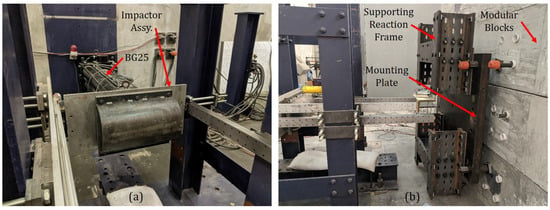
Figure 2.
Testing System: (a) Impact components—alternate view, (b) Reaction components—clamping assemblies not installed.
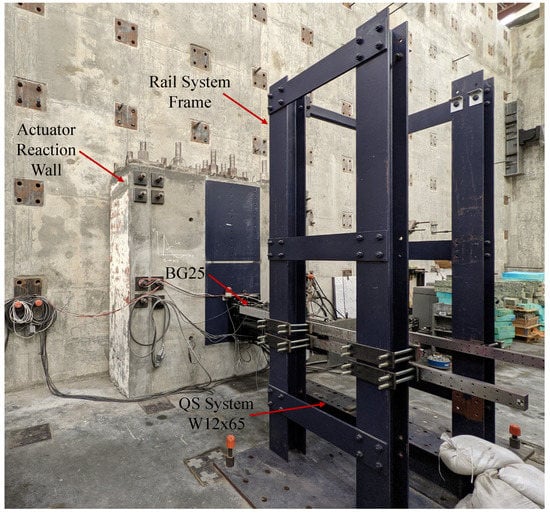
Figure 3.
Impact components.
Impulsive loading is applied using the BG, an ultra-high velocity, computer-controlled, hydraulic actuator (Figure 4). The BG delivers an impulse by impacting a specimen with a variable mass at a controlled rate and duration in a highly repeatable manner. The model BG25 is capable of accelerating a 110 lbs (50 kg) mass up to 112 ft/s (34 m/s) [26]. Pressurized oil, which is further compressed using nitrogen gas in a pressure accumulator, enables high actuator velocities. The piston rod is accelerated as the poppet valve opens and releases the pressurized hydraulic oil into the acceleration chamber. Similarly, the opening and closing of the poppet valves are controlled to release hydraulic oil from the acceleration chamber. The combination of the deceleration chamber nitrogen gas pressure and the depressurization of the acceleration chamber causes the piston rod to retract in a controlled manner. The impactor may be fired in one of two modes: flyer or impactor. This research utilizes the impactor mode, where the impactor is mechanically fastened to the actuator piston rod and remains attached throughout the test. The BG is programmed such that the target velocity is reached upon impact with the specimen. The impact with the specimen and programming of the BG will cause deceleration of the mass and retraction of the piston rod and impactor. The process described for the impactor mode allows for the delivery of a singular pulse to a specimen and allows for the loading history to be tailored to be blast-like in duration and shape. There is evidence that the rolling shear failure mode may be sensitive to damage accumulation [8]; therefore, preventing the introduction of multiple pulses by the BG via the use of the impactor mode or specimen response is critical. Additional details regarding the blast generator at Georgia Tech are provided by Stewart et al. [27]. Freidenberg [28] provides additional details regarding the firing modes possible with the blast generator.
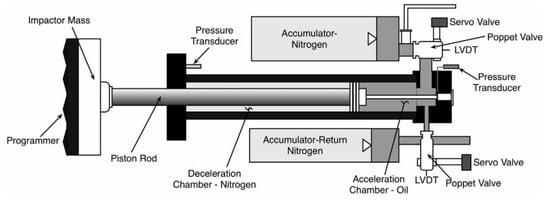
Figure 4.
Schematic of the MTS blast generator.
The supporting reaction frame, shown in Figure 5 and Figure 6, is a three-point flexural testing fixture that provides supports for the specimen and clamps it in a vertical orientation. The reaction frame is divided into an upper and a lower support frame. Two discrete frames were designed to prevent visual obstruction of a specimen’s response to an impact. The reaction frame beams are designed with slotted holes to enable the adjustment of the specimen length by moving the cross beams. Four built-up beams act as guides and supports to the cross beams.

Figure 5.
Supporting reaction frame design: (a) perspective view, (b) side view.
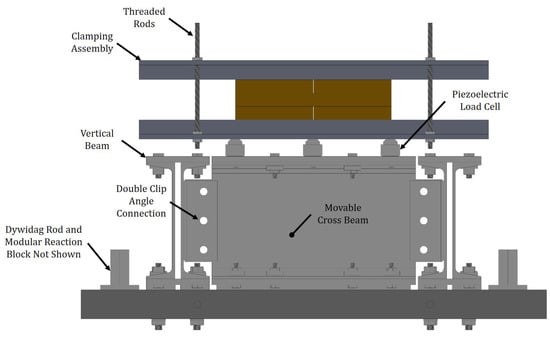
Figure 6.
Supporting reaction frame, top view.
Two clamping assemblies, top and bottom, are affixed to the reaction frame. Each clamping assembly has four threaded rods that are tightened to a specified torque value. The clamping force provided by each assembly limits the rotation of the specimen at the support, thereby setting a control on rotational rigidity. The clamping force is introduced via torque applied to the nut securing the top plate. The torque force is measured using a torque wrench, and a conversion is applied to the torque reading to account for the use of an open ended tight-clearance offset socket, or “crowfoot wrench” (Figure 7). The torque equation is given as Equation (1). For the experiment, three levels of torque (65 in-lbs, 130 in-lbs, and 200 in-lbs) were selected to provide data for a wide range of rotational rigidities at the specimens’ boundary conditions.
where
- Torque exerted at the end of the adapter
- Distance between square drive and hand position
- Wrench scale reading
- Length of adapter or extension
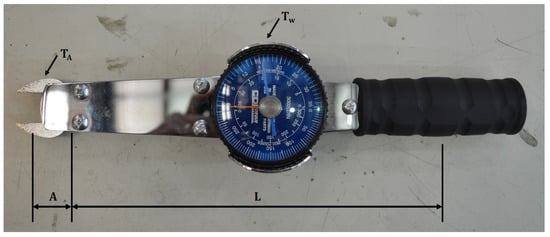
Figure 7.
Torque wrench.
The impactor assembly, shown in Figure 8 and Figure 9, was fabricated with a rounded face to reduce high-stress concentrations caused by a concentrated center-point load. Concentrated loads have been shown to affect the shear deformation of CLT in the area of the load, thereby changing the longitudinal strain [21,29]. The impactor is half of a large diameter, ASTM A500 Gr.B, steel structural tube section, HSS10.75×0.5, fastened to ASTM A36 plates. A 0.5 in thick firm felt type F5 programmer is adhered to the impactor’s face. The radius of the impactor was selected to achieve a radius-to-CLT-lamella-thickness ratio of 4 (i.e., 5.375 in/1.375 in). The radius of the impactor conforms to the recommendations of ASTM D198, radius of curvature 2-to-4 times the depth, and Hou [30], radius of curvature 2.5-to-3 times the depth. The impactor mass is 111.52 lbs (50.46 kg).
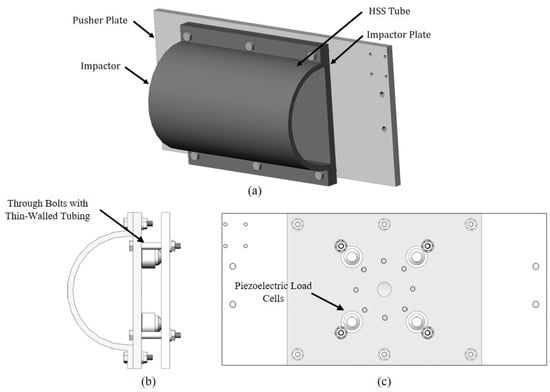
Figure 8.
Impactor design: (a) perspective view, (b) side view, and (c) back view with pusher plate in foreground.
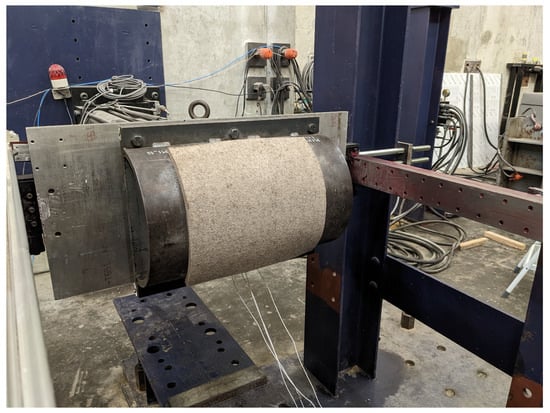
Figure 9.
Impactor with load cells attached to pusher plate.
Four piezoelectric dynamic force sensors were mounted to the impactor plate. The impactor and load cells were connected to the actuator pusher plate using four through-bolts with thin-walled tubing to reduce friction and catching of the threads. The thin-walled tubing extended the length of the bolt shank and threading, so as the impactor struck a specimen, the load cells were compressed between the impactor plate and the pusher plate, causing each of the plates to slide along the bolt shank or threading. The force sensors were preloaded with approximately 2000 lbf (8.9 kN) to 6500 lbf (29 kN) on average. Preloading ensured that each load cell received equal loading from an impact and eliminated delay in load cell response due to excess space. Preloading also served to maintain the impactor level and motion rigid.
2.3. Impulsive Center-Point Test Methodology
During an impulsive center-point test (Figure 10), the actuator piston rod drives the impactor forward until the target velocity is reached. The impactor strikes the CLT specimen at velocities ranging from approximately 15 ft·s (4.57 m·s) to 42 ft·s (12.8 m·s). The force time histories were sensed via a series of 50 kip (222.4 kN) capacity Dytran 1061V6 piezoelectric load cells. Four load cells were anchored to the impactor assembly, and three load cells were anchored between each clamping fixture and the flange of each cross beam, totaling ten load cells. Force histories were recorded by a Hi-Techniques Synergy data acquisition system (DAQ) at 1 MS/s for a total of 200 ms. The response of the specimens and overall system was captured using two high frame rate cameras, Phantom Miro C110 and Phantom Miro M310. The Phantom Miro M310 was used to capture the overall response of the system including the support frame, specimen, and impactor. The Phantom Miro C110 was used to capture a view of the thickness of the specimen at the midspan. The ProAnalyst Professional Edition [31] was used for motion tracking of the impactor and specimen and to provide displacement and velocity data. Maximum and residual displacements, as well as the displacement for each specimen at peak resistance, were determined.
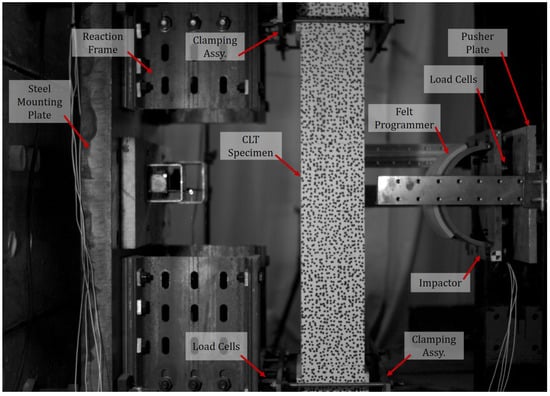
Figure 10.
Impulsive center-point test setup.
To implement digital image correlation (DIC), each CLT specimen was speckled along its thickness using a randomly generated speckle pattern with a speckle diameter of 0.22 in (5.59 mm). Full-field planar displacement gradients were generated using DIC along the thickness of each specimen. The displacement gradients were post-processed to obtain the strain gradients. Deformation and strain gradients were calculated using NCorr DIC software by Blaber et al. [32].
2.4. Impulsive Loading
The four piezoelectric loads fastened to the impactor assembly were used to determine the impulsive loading applied to each specimen. Two tests were conducted for each specimen, a test with impact and a test with no impact, i.e., a dry-fire test. The force histories for each load cell are summed, and the difference between the sums is taken to determine the net force history applied (Equation (2)).
The reaction force histories are summed by support, i.e., upper support reaction force history and lower support reaction force history, and as a total reaction force history (Equation (3)).
Impact and reaction impulses are calculated by taking the integral of each respective force history (Equation (4)).
The method described is called the Direct Force Method [33]. The Direct Force Method allows for the direct comparison and quantification of the force delivered to the specimen while allowing for the removal of inertial forces recorded by the load cells when the impactor mass is accelerated to the target velocity. Figure 11, Figure 12, Figure 13, Figure 14 and Figure 15 illustrate the product of completing these calculations for a representative test. Note that negative forces represent lesser levels of compression with respect to the preload compression force.
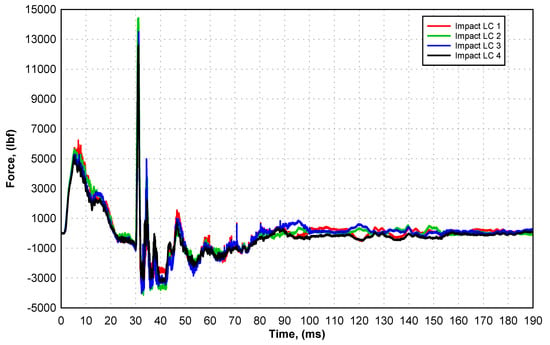
Figure 11.
Individual impact load cell readings for CLT5-10 specimen.
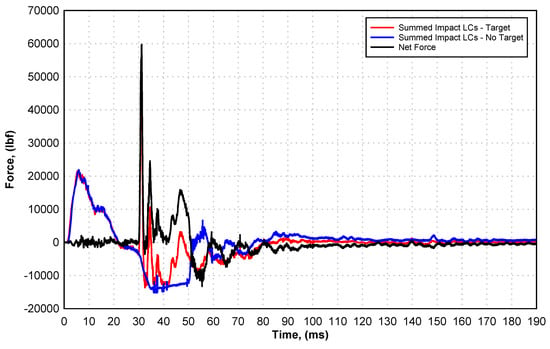
Figure 12.
Summed force histories for CLT5-10 specimen.

Figure 13.
net impact force and impulse for CLT5-10 specimen.

Figure 14.
reaction forces and impulse for CLT5-10 specimen.

Figure 15.
Net impact and reaction impulses for the CLT5-10 specimen.
3. Results
3.1. Impulsive Testing
A total of 35 impulsive tests were completed: 18 tests on three-laminae CLT and 17 tests on five-laminae CLT. Table 1 and Table 2 detail the test matrix for the series.

Table 1.
Impulsive Center-Point Test Matrix for Three-Laminae CLT.

Table 2.
Impulsive Center-Point Test Matrix for Five-Laminae CLT.
3.2. Effect of Impulsive Loading on CLT Panel Dynamic Apparent Flexural Stiffness
The effect of impulsive loading on CLT panels was studied by evaluating changes to their mechanical properties and characterizing damage caused in relation to variations in rotational rigidity at the boundary conditions and impact energy. The dynamic apparent flexural stiffness, , was determined for each specimen by taking the slope of the linear, pre-peak region of the resistance function. Additionally, a high-speed video was reviewed to ensure that no visible damage had initiated in each specimen prior to the development of the peak impact force. A ratio, was used to compare the dynamic apparent flexural stiffness to the average apparent flexural stiffness for quasi-statically loaded specimens, . The experiments showed a significant increase in dynamic apparent flexural stiffness in both three- and five-laminae specimens (Figure 16 and Figure 17).
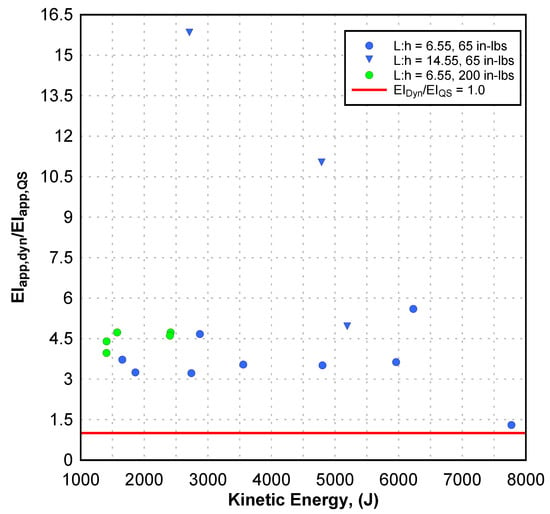
Figure 16.
Dynamic apparent stiffness ratio for three-laminae specimens.
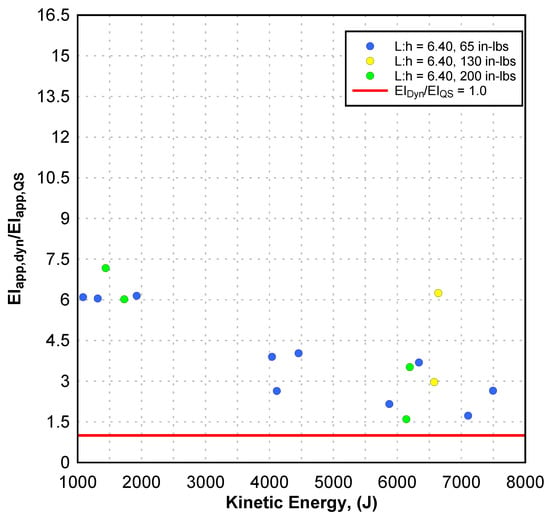
Figure 17.
Dynamic Apparent stiffness ratio for five-laminae specimens.
At energies ranging from 1000 J to 2000 J, the five-laminae specimens exhibited a higher amplification of their dynamic apparent flexural stiffness than the three-laminae specimens. The higher amplification in dynamic apparent flexural stiffness in the five-laminae specimens may be due to a combination of the following factors: redundancy inherent in the presence of additional logitudinal laminae in five-laminae specimens; increased stiffness due to the geometry of the five-laminae specimens; and amplification of the shear modulus in the cross laminae (i.e., rolling shear modulus, ) due to high-rate impulsive loading and the presence of multiple cross layers in five-laminae CLT.
At higher impact energies, there was a marked decrease in the stiffness ratio for the five-laminae CLT. The three-laminae specimens, however, displayed a consistent stiffness ratio between approximately 3.0 and 4.5 for most impact energies tested. In both the three- and five-laminae specimens, stiffness ratios are higher at lower energy levels and drop dramatically once a certain level of impact energy is reached, thereby creating distinct impact energy zones. A similar phenomenon is also noted in the three-laminae specimens with L:h = 14.55, although additional tests are required to determine a trend for these specimens in particular. In the three-laminae CLT specimens, the transition between zones occurs at a higher level of impact energy, (6500 J ≤≤ 7500 J), as compared to the five-laminae specimens (2000 J ≤≤ 4000 J).
At higher levels of boundary-condition rotational rigidity, the three-laminae CLT exhibited a greater increase in dynamic stiffness (6% to 47%) compared to specimens tested at the baseline torque (i.e., T = 65 in-lbs) and similar impact energies. Increased boundary condition rotational rigidity in five-laminae CLT did not appear to affect the dynamic stiffness and no clear relationship was noted.
3.3. Damage Characterization
Varying degrees of damage were observed following impulsive loading. Greater degrees of damage were a function of the impact energy and impulse applied. All specimens were tested within a range of 1.0 kJ to 8.0 kJ of impact energy and exhibited slight damage to complete panel failure. In this research, slight damage is characterized as little to no damage in the form of visible shear or flexural cracks, zero or low residual displacement, and a residual load capacity that is within 10% to 20% of the average quasi-static load capacity. Heavy damage is characterized by partial rupturing of the extreme tensile and compressive laminae, presence of shear cracks, high residual displacement, and significant loss in residual capacity (≥50%) of quasi-static capacity. Complete failure is characterized by failure of all lamellas in the tensile face lamina oriented in the major strength direction of the CLT panel.
3.3.1. Evaluation of Observed Failure Modes in Low Span-to-Depth Ratio (6.40 ≤ L:h ≤ 6.55) Specimens
While specimens generally exhibited a mixture of shear and flexural failure modes, all specimens consistently exhibited rolling shear and longitudinal shear failures that occurred at and immediately following impact. The shear failures were often followed by widening of the rolling shear cracks, the nucleation of additional rolling shear cracks, and the growth of longitudinal shear cracks. Shear failures in CLT led to the loss of composite action and resulted in load being increasingly redistributed to the longitudinal laminae, followed by complete failure of the specimen, in specimens that experienced failure. Complete failure was categorized by flexural failure modes, i.e., tensile rupture and/or compressive crushing, in the longitudinal laminae, which typically occurred several milliseconds following impact. The testing fixture proved to be effective at consistently eliciting rolling shear failure modes in every low span-to-depth ratio specimen regardless of test parameters such as peak force, duration of load, impact energy, or boundary condition rotational rigidity.
Figure 18 and Figure 19 provide images of CLT specimens loaded at varied impact energies and prior to the development of flexural failure modes. Figure 18 shows specimens CLT3-2 ( kj), CLT3-5 ( kj), and CLT3-18 ( kj) several milliseconds following impact. In each specimen, a combination of rolling shear and longitudinal shear cracks is evident. In panels that exhibited moderate damage to complete failure, flexural failures such as longitudinal cracks and rupture, were noted in the lamellas oriented in the major strength direction. Flexural failures occurred several milliseconds after impact and the development of shear cracks.
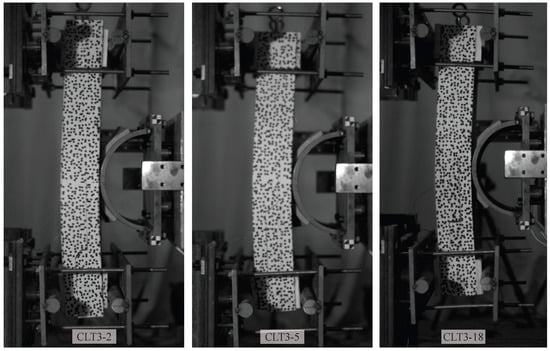
Figure 18.
Comparison of damage in three-laminae clt at varied impact energies. From Left to Right: CLT3-2 ( kJ), CLT3-5 ( kJ), CLT3-18 ( kJ).
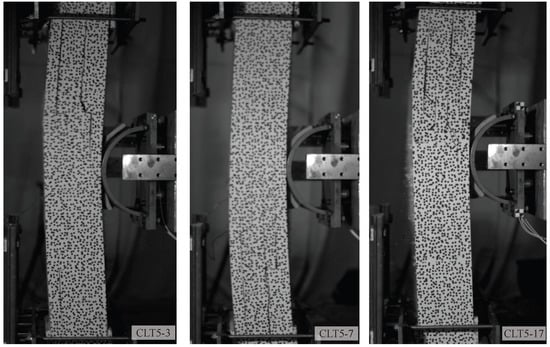
Figure 19.
Comparison of damage in five-laminae clt at varied impact energies. From Left to Right: CLT5-3 ( kJ), CLT5-7 ( kJ), CLT5-17 ( kJ).
In panels that exhibited failure and experienced heavy damage to complete failure, a dramatic loss in resistance was noted following the development of the initial rolling shear cracks. As resistance falls, longitudinal shear cracks develop, which caused partial to complete delamination and allowed the laminae to slip, thus resulting in the loss of composite action. As composite action was lost, the longitudinal laminae began to rupture. In panels that did not exhibit failure and instead exhibited slight damage, loss of resistance was not due to rolling shear failures and was instead due to load reversal caused by the impactor retracting. Note that longitudinal shear cracks observed throughout this research occurred through the wood fibers and not the adhesive boundary layer, indicating that the failures were not caused by failure of the adhesive.
Figure 20 shows the resistance history for a representative test where the specimen experienced complete failure, specimen CLT3-2. At 40.79 ms, peak resistance was reached, and rolling shear and longitudinal shear cracks had just developed and resulted in some delamination and slip between the laminae (Figure 21). Following this time, the resistance dropped dramatically, and by 42.70 ms, the longitudinal laminae began to rupture.
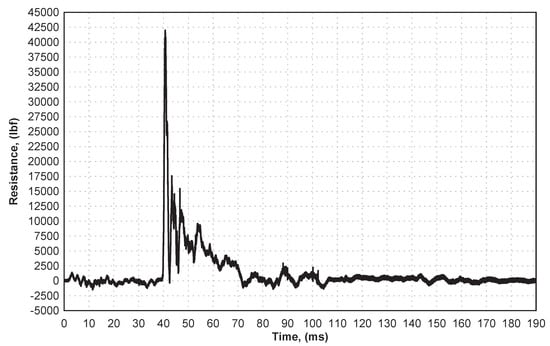
Figure 20.
Resistance history for CLT3-2.
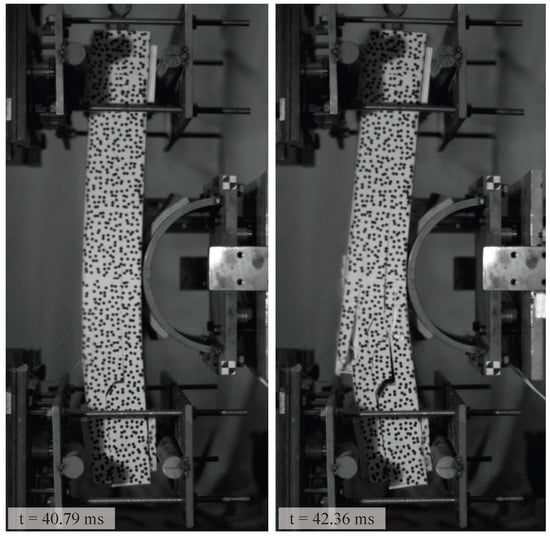
Figure 21.
Comparison of damage in CLT3-2.
3.3.2. Net Force History as a Damage Characterization Tool
The design of the impactor assembly, which featured dynamic load cells, allowed for the determination of the net impact force history applied to each specimen. The net impact force history provides data on the precise moment of contact between the impactor and specimen and the duration of the impact. The net impact force history made it possible to observe the development of new damage in the specimens based on fluctuations in the forces sensed by the impact load cells. The net impact force history data were paired with a review of the high-speed video footage to characterize failure modes. Figure 22 illustrates the net force history for specimen CLT5-10 with an impact that occurred at 36.72 ft/s (11.19 m/s). Significant fluctuations in the force throughout the history were observed to be correlated with the development of new damage, e.g., a shear crack, or the growth of damage that occurred earlier in the impact event. In Figure 22, several significant fluctuations in force are labeled, and and these fluctuations are discussed below.
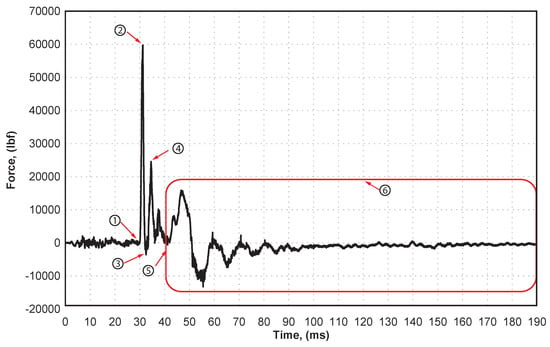
Figure 22.
CLT5-10 Damage detection in net impact force history.
- t = 29.82 ms: Contact between the felt programmer and specimen is made. Load rapidly increases beyond this point in time.
- t = 31.23 ms: Peak force occurs at this time. Rolling shear cracks located above and below the mid-span develop and widen during the load duration.
- t = 31.23 to 32.51 ms: Crushing in the lower and upper support plywood bearing plates is observed. Additional rolling shear cracks and longitudinal cracks develop. The crushing of the bearing plates and the development of shear cracks promote the rapid decline of force.
- t = 32.51 to 34.55 ms: Crushing of bearing plate plywood continues. Tensile rupturing commences in a single lamella in the extreme tensile lamina, and longitudinal flexural cracks develop in the extreme compressive lamina.
- t = 34.55 ms to 37.44 ms: Progressive tensile rupturing of the lamellas in the extreme tensile lamina. Fall and rise of force is indicative of failure of individual CLT components or the occurrence of damage and the subsequent redistribution of load.
- t = 37.44 ms to 43.35 ms: Complete failure of the extreme tensile lamina occurs. Rapid oscillations in the net force history are caused by bending of the wood fibers in the lamella in the extreme tensile lamina.
- t = 43.35 ms to 46.65 ms: Peaks at and after this point occur due to the deceleration and retraction of the impactor and the wobbling of the aluminum pusher plate toward and away from the direction of impact.
Figure 23 shows frames from the high-speed video at the approximate time associated with the net impact force history times described above. Note, the numbering in Figure 23 references the numbering in Figure 22. Figure 24 shows the CLT5-10 post test.
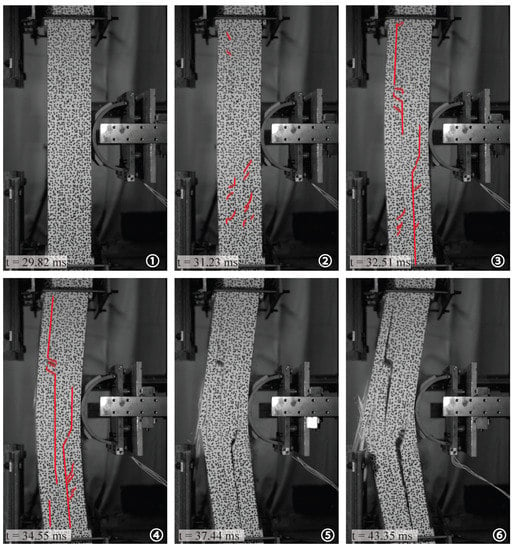
Figure 23.
CLT5-10 Damage progression.

Figure 24.
CLT5-10 Post-dynamic test.
The damage progression for three-laminae CLT specimens developed in a similar fashion to the five-laminae specimen. Rolling shear cracks typically preceded longitudinal shear cracks, followed by the progressive rupturing of the tensile lamellas and the eventual failure of the specimen. Figure 25 illustrates the net impact force history for specimen CLT3-5 with an impact that occurred at 9.93 m/s (32.58 ft/s). Significant fluctuations in force are labeled and are discussed below.
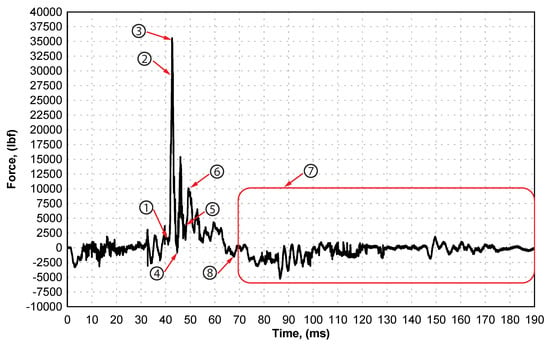
Figure 25.
CLT3-5 Damage detection in net impact force history.
- t = 41.556 ms: Contact between the felt programmer and specimen is made. Load rapidly increases beyond this point in time.
- t = 42.493 ms: Rolling shear cracks develop in the lower half of the specimen. A RS crack merges with a longitudinal shear crack that spreads the lower boundary in the beam, causing partial loss of composite action.
- t = 42.600 ms: Peak force occurs at this time.
- t = 43.431 ms: RS cracks that previously developed continue to widen. A longitudinal flexural crack develops in the compressive lamina and a lamella in the tensile lamina ruptures. Following this point in time, lamellas in the tensile lamina progressively rupture until the complete failure of the panel.
- t = 47.649 ms: Tensile lamina completely fails.
- t = 49.211 ms: Compressive lamina ruptures.
- t = 49.211 ms to 190 ms: Fluctuations in force history are primarily due to deceleration and retraction of the impactor and the resulting wobbling of the aluminum pusher plate toward and away from the direction of impact.
- t = 68.362 ms: Contact between the impactor and specimen ends.
Figure 26 shows frames from the high-speed video at the approximate time associated with the net impact force history times described above. Note, the numbering in Figure 26 references the numbering in Figure 25. Figure 27 shows CLT3-5 post-test. An important observation from this study is that in both specimens, the time the specimen is under contact is far longer (≥10 ms) than the duration of any of the peaks labeled in the net impact force histories. During the time under contact, the impactor advances toward the specimen, and contact is lost once the impactor begins to retract. It may be concluded that each change in force history is indicative of the development of damage in the specimen or a change in momentum of the impactor.

Figure 26.
CLT3-5 Damage progression.
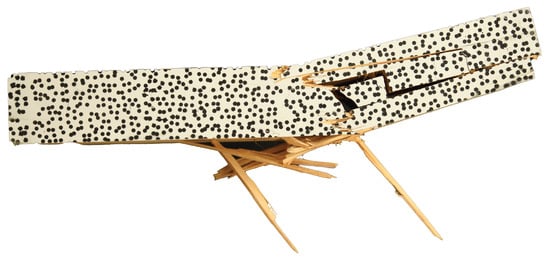
Figure 27.
CLT3-5 Post dynamic test.
Digital image correlation was implemented to observe the strain gradients present through the thickness of the CLT specimens. Figure 28 shows the , , and strain gradients for a representative specimen, CLT5-10, calculated using DIC. At 32.51 ms, several shear cracks were observed, as well as a massive loss in resistance. Strain concentrations in the DIC plots overlap where shear cracking was observed, and there was no indication of other modes of failure. The strain gradients support the observations that the shear modes of failure were the primary contributors to the loss in resistance of the panel, and that flexural failure modes were largely absent at this time.
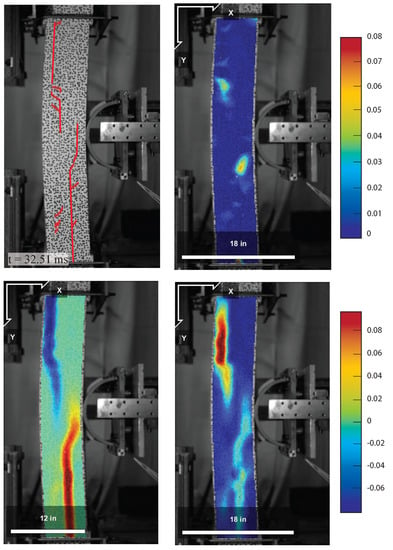
Figure 28.
CLT5−10 during impulsive loading at t = 32.51 ms. Counterclockwise From Top Left: Photograph of CLT5-10, strain gradients for , , and calculated using DIC.
3.3.3. Influence of Boundary Condition Rotational Rigidity on CLT Damage
Figure 29 and Figure 30 plot the maximum inbound displacements as a function of impact energy for the three-laminae and five-laminae specimens, respectively.
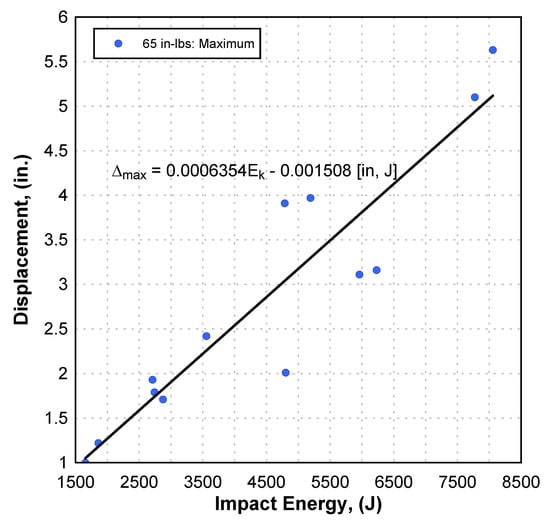
Figure 29.
Maximum inbound displacements for three-laminae specimens.
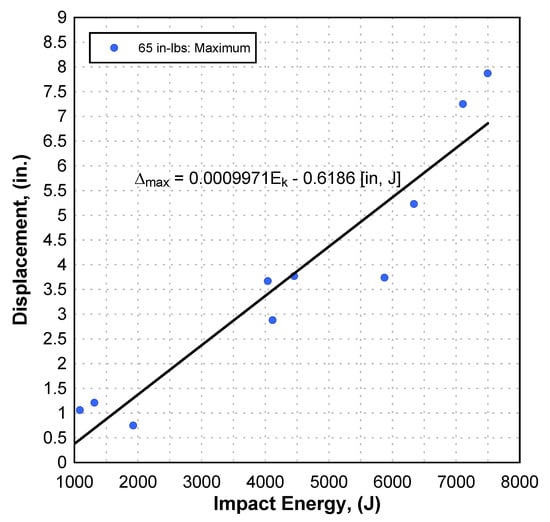
Figure 30.
Maximum inbound displacements for five-laminae specimens.
Linear regressions of the data show a coefficient of determination of and for maximum inbound displacement as a function of impact energy for the three- and five-laminae specimens, respectively. The high degree of linearity is logical as they state that the maximum displacements in the CLT panels increase with increasing impact energy. The linear relationship between maximum inbound displacement and impact energy may be described by Equations (5) and (6) for the three- and five-laminae CLT specimens, respectively.
Figure 31 and Figure 32 plot the maximum inbound and residual displacements for the three- and five-laminae CLT panel tests, respectively. A torque of 65 in-lbs was used as the baseline torque parameter for comparison with higher levels of torque. At this level torque, the restraining moment at the boundary conditions is relatively low, and specimens tested at this level of torque behave mostly as simple beams. Resistance functions for a beam with ideal simple boundary conditions and the test fixture’s boundary conditions were observed to be similar, thus demonstrating that the specimens behaved mostly as simple beams at the baseline torque.
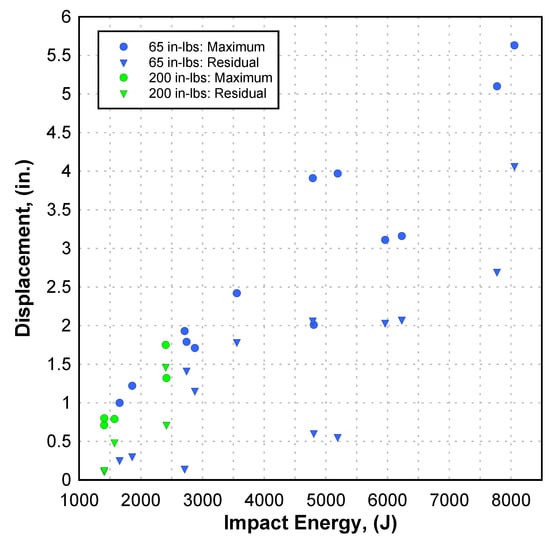
Figure 31.
Residual and maximum inbound displacements for three-laminae specimens.
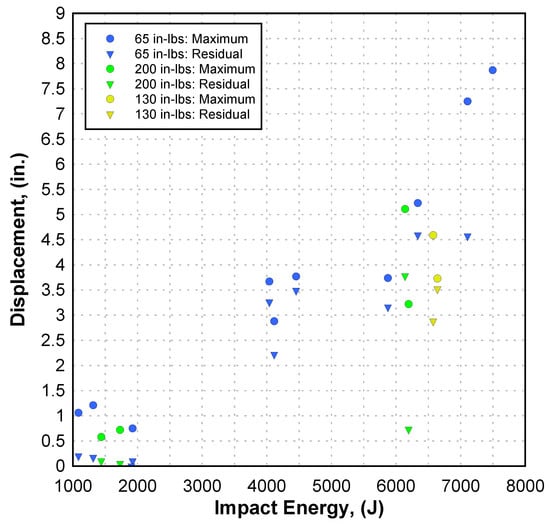
Figure 32.
Residual and maximum inbound displacements for five-laminae specimens.
At impact energies of 3.5 kJ and greater, three-laminae specimens experienced complete failure, while five-laminae specimens experienced failure at impact energies of 6.1 kJ and greater. Some variability in the impact energies that caused complete failure was noted, as contrasted to the three-laminae tests, which showed greater consistency.
At the higher levels of rotational rigidity, three-laminae CLT specimens exhibited lesser maximum inbound displacements as compared to specimens with the baseline level of rotational rigidity and tested at similar impact energies. Tests on five-laminae CLT where torque was varied were conducted at two impact energy ranges: 1.0 kJ to 2.0 kJ and 6.0 kJ to 6.5 kJ. At lower impact energies, i.e., 1.0 kJ to 2.0 kJ, specimens tested with 200 in-lbs of torque exhibited 4.0% to 43.1% lower maximum inbound displacement than the baseline tests torqued to 65 in-lbs. While the residual displacements for the specimens tested with 200 in-lbs of torque were lower than those of the baseline tests (0% to 75%), they were fairly similar in magnitude and indicated that minimal damage occurred at lower impact velocities. At higher impact energies, i.e., 6.0 kJ to 6.5 kJ, lower maximum inbound displacements were observed in specimens tested with 130 in-lbs (12.24% to 28.68%) and 200 in-lbs (2.3% to 38.43%) of torque. Similarly, lower residual displacements were observed is specimens tested with 130 in-lbs (12.24% to 28.68%) and 200 in-lbs (2.3% to 38.43%) of torque. Additional tests at 130 in-lbs and 200 in-lbs of torque are required at the tested velocities and middle velocities not tested in order to establish whether the above observations hold at other velocities and if there is a function that describes the relationship between displacement and energy for the higher torques tested.
The observations on the maximum and residual displacement data are indicative of lower levels of damage in specimens with higher levels of rotational rigidity at the boundary condition in both CLT panel layups tested.
4. Conclusions
Impulsive loading was applied to low span-to-depth ratio (6.40 ≤ L:h ≤ 6.55) CLT panels in a center-point loading condition to promote shear modes of failure. A novel testing fixture was developed and used to mount and restrain CLT specimens subjected to impulsive loading via an ultra-high-velocity actuator. Three levels of boundary-condition rotational rigidity were tested to study its effect on CLT panel behavior. The test series was successful at eliciting rolling shear and longitudinal interlaminar shear failures in all CLT panels tested. Analysis of the resistance history verified that resistance dropped dramatically following the development of shear cracking. No dependency was noted on geometrical parameters, such as CLT layup, or test parameters, such as boundary condition rotational rigidity, span-to-depth ratio, impact energy, peak load, load duration, or impact impulse. Shear modes of failure have been largely absent from CLT panels that undergo live blast testing. The results and observations from these experiments suggest that the occurrence of shear modes of failure in impulsively loaded CLT panels may be due to the load condition and span-to-depth ratio rather than the boundary conditions, CLT panel layup and geometry, or intensity and duration of loading. The literature further supports this hypothesis as shear modes of failure have been observed in shock-tube testing of CLT where a four-point bending loading condition was employed [7]. A uniform loading condition, as may be applied by live blast loading, should be explored.
Strain rate effects were noted in the apparent flexural stiffness of all specimens tested. The dynamic apparent flexural stiffness of CLT was 1.3 to 7.2 times greater than the quasi-static apparent flexural stiffness. For the three-laminae specimens, stiffness ratios were consistent across most kinetic energies tested with the stiffness ratio dropping at the higher end of the energies tested. For the five-laminae specimens, stiffness ratios were consistent at the lower range of kinetic energies tested, i.e., 1.0 kJ to 2.0 kJ, with stiffness ratios exhibiting a decreasing trend with increasing kinetic energies above a kinetic energy of approximately 4.0 kJ. There appears to be a transition zone in the stiffness ratios for kinetic energies ranging from 2.0 kJ to 4.0 kJ; testing was not conducted in this energy range, and as a result, additional testing is required to capture the change in stiffness in this range.
The presence of shear modes of failure resulted in the dramatic loss of resistance in all specimens tested. The resistance histories provided a method for correlating loss of resistance to the development of damage. Additionally, the Direct Force Method may be used to aid in the characterization of damage in CLT. The development of a resistance function that captures CLT post-peak behavior is required as experimental data and analytical tools are limited.
Lower levels of damage were observed in specimens with higher levels of boundary condition rotational rigidity. This observation implies that the provision of stiffer boundary conditions can reduce damage in impulsively loaded CLT panels. Additionally, relationships that correlate impact kinetic energy with maximum inbound displacement were developed for both CLT layups tested (Equation (5) (three-laminae) and Equation (6) (five-laminae)).
Author Contributions
Conceptualization, N.R.F. and L.K.S.; methodology, N.R.F.; software, N.R.F.; validation, N.R.F.; formal analysis, N.R.F.; investigation, N.R.F.; resources, L.K.S. and R.G.; writing—original draft preparation, N.R.F.; writing—review and editing, L.K.S. and R.G.; visualization, N.R.F.; supervision, L.K.S.; project administration, L.K.S.; funding acquisition, L.K.S. and R.G. All authors have read and agreed to the published version of the manuscript.
Funding
This work was supported by the United States Forest Service (USFS) through the Wood Innovations Grant under USFS Domestic Grant 17-DG-11083150-008. Any opinions, findings, and conclusions or recommendations expressed in this material are those of the authors and do not necessarily reflect the views of the United States Forest Service.
Institutional Review Board Statement
Not applicable.
Informed Consent Statement
Not applicable.
Data Availability Statement
This study did not report any data.
Acknowledgments
We would like to thank the many people who helped make this research possible from assistance with fabrication to helping run experiments: Jeremy Mitchell, Andy Udell, Jeremy Stephens, Nan Gao, Giovanni Loreto, Diana Estrada, Rebecca Nylen, Brian Riser, Maria Warren, Jonathan Johnson, Hanna Kessler, Lixrine Ngeme, Gino Pagliaro, John Respert, Alexander Rice, Larissa Simoes Novelino, Juliet Swinea, Miranda Tan, Thomas Vandiver, and Isaac Wasson.
Conflicts of Interest
The authors declare no conflict of interest.
Abbreviations
The following abbreviations are used in this manuscript:
| ANSI | American National Standards Institute |
| APA | The Engineered Wood Association |
| BG | Blast Generator |
| CLT | Cross-Laminated Timber |
| Dyn | Dynamic |
| LC | Load Cell |
| QS | Quasi-static |
| RS | Rolling Shear |
| SPFS | Spruce–Pine–Fir–South |
References
- Karacabeyli, E.; Brad, D. CLT Handbook, U.S. Edition; Technical Report; FPInnovations: Pointe-Claire, QC, Canada, 2013. [Google Scholar]
- Brandner, R.; Tomasi, R.; Moosbrugger, T.; Serrano, E.; Dietsch, P. Properties, Testing and Design of Cross Laminated Timber: A State-of-the-Art Report by COST Action FP1402/WG2; Technical Report; Shaker Verlag: Aachen, Germany, 2018. [Google Scholar] [CrossRef]
- Crespell, P.; Gagnon, S. Cross Laminated Timber: A Primer; Fpinnovations: Vancouver, QC, Canada, 2010. [Google Scholar]
- Sanborn, K.P. Exploring Cross-Laminated Timber Use for Temporary Military Structures: Ballistic Considerations. Ph.D. Thesis, Georgia Institute of Technology, Atlanta, GA, USA, 2018. [Google Scholar]
- Sanborn, K.; Gentry, T.R.; Koch, Z.; Valkenburg, A.; Conley, C.; Stewart, L.K. Ballistic performance of Cross-laminated Timber (CLT). Int. J. Impact Eng. 2019, 128, 11–23. [Google Scholar] [CrossRef]
- Weaver, M.K.; Newberry, C.; O’Laughlin, C.; Podesto, L. Experimental Results of Full-Scale Cross-Laminated Timber Structures; Technical Report; Karagozian & Case: Glendale, CA, Canada, 2017. [Google Scholar]
- Poulin, M.; Viau, C.; Lacroix, D.N.; Doudak, G. Experimental and Analytical Investigation of Cross-Laminated Timber Panels Subjected to Out-of-Plane Blast Loads. J. Struct. Eng. 2018, 144, 04017197. [Google Scholar] [CrossRef]
- Côté, D.; Doudak, G. Experimental investigation of cross-laminated timber panels with realistic boundary conditions subjected to simulated blast loads. Eng. Struct. 2019, 187, 444–456. [Google Scholar] [CrossRef]
- Viau, C.; Doudak, G. Behaviour and modelling of cross-laminated timber panels with boundary connections subjected to blast loads. Eng. Struct. 2019, 197, 109404. [Google Scholar] [CrossRef]
- Lopez-Molina, A.; Doudak, G. Retrofit techniques for Cross-Laminated Timber (CLT) elements subjected to blast loads. Eng. Struct. 2019, 197, 109450. [Google Scholar] [CrossRef]
- Van Le, T.; Ghazlan, A.; Ngo, T.; Remennikov, A.; Kalubadanage, D.; Chern Jinn Gan, E. Dynamic increase factors for Radiata pine CLT panels subjected to simulated out-of-plane blast loading. Eng. Struct. 2020, 225, 111299. [Google Scholar] [CrossRef]
- Reid, S.R.; Peng, C. Dynamic uniaxial crushing of wood. Int. J. Impact Eng. 1997, 19, 531–570. [Google Scholar] [CrossRef]
- Harrigan, J.J.; Reid, S.R.; Peng, C. Inertia effects in impact energy absorbing materials and structures. Int. J. Impact Eng. 1999, 22, 955–979. [Google Scholar] [CrossRef]
- Harrigan, J.J.; Reid, S.R.; Tan, P.J.; Reddy, T.Y. High rate crushing of wood along the grain. Int. J. Mech. Sci. 2005, 47, 521–544. [Google Scholar] [CrossRef]
- Widehammar, S. Stress-Strain Relationships for Spruce Wood: Influence of Strain Rate, Moisture Content and Loading Direction. Exp. Mech. 2004, 44, 44–48. [Google Scholar] [CrossRef]
- Allazadeh, M.R.; Wosu, S.N. High strain rate compressive tests on wood. Strain 2012, 48, 101–107. [Google Scholar] [CrossRef]
- ANSI/APA PRG 320-19; Standard for Performance-Rated Cross-Laminated Timber. American National Standards Institutes—ANSI/APA: Tacoma, WA, USA, 2020.
- Zhou, Q.Y.; Gong, M.; Chui, Y.H.; Mohammad, M. Measurement of rolling shear modulus and strength of cross-laminated timber using bending and two-plate shear tests. Wood Fiber Sci. 2014, 46, 259–269. [Google Scholar]
- Bogensperger, T.; Silly, G.; Schickhofer, G. 2.2.3 Comparison of Methods of Approximate Verification Procedures for Cross Laminated Timber; Technical Report; Holz.Bau Forschungs Gmbh: Graz, Austria, 2012. [Google Scholar]
- Hindman, D.P.; Bouldin, J.C. Bending and shear stiffness of cross-laminated timber using a variable span bending test. J. Test. Eval. 2019, 47, 2464–2475. [Google Scholar] [CrossRef]
- Mestek, P.; Kreuzinger, H.; Winter, S. Design of Cross Laminated Timber (CLT). In Proceedings of the 10th World Conference on Timber Engineering 2008, Miyazaki, Japan, 2–5 June 2008; Volume 1, pp. 156–163. [Google Scholar]
- Zhou, Q.; Gong, M.; Chui, Y.H.; Mohammad, M. Measurement of rolling shear modulus and strength of cross laminated timber fabricated with black spruce. Constr. Build. Mater. 2014, 64, 379–386. [Google Scholar] [CrossRef]
- Li, Y.; Lam, F. Low cycle fatigue tests and damage accumulation models on the rolling shear strength of cross-laminated timber. J. Wood Sci. 2016, 62, 251–262. [Google Scholar] [CrossRef][Green Version]
- Cao, Y.; Street, J.; Li, M.; Lim, H. Evaluation of the effect of knots on rolling shear strength of cross laminated timber (CLT). Constr. Build. Mater. 2019, 222, 579–587. [Google Scholar] [CrossRef]
- Crovella, P.; Smith, W.; Bartczak, J. Experimental verification of shear analogy approach to predict bending stiffness for softwood and hardwood cross-laminated timber panels. Constr. Build. Mater. 2019, 229, 116895. [Google Scholar] [CrossRef]
- Stewart, L.K.; Freidenberg, A.; Rodriguez-Nikl, T.; Oesterle, M.; Wolfson, J.; Durant, B.; Arnett, K.; Asaro, R.J.; Hegemier, G.A. Methodology and validation for blast and shock testing of structures using high-speed hydraulic actuators. Eng. Struct. 2014, 70, 168–180. [Google Scholar] [CrossRef]
- Stewart, L.K.; Gao, N.; Pezzola, G.; Sanborn, M.; Sanborn, K.; Nail, A.; Loreto, G. Georgia institute of technology laboratory for blast, shock and impact. In Proceedings of the International Conference on Advances in Experimental Structural Engineering, Pavia, Italy, 6–8 September 2017; pp. 685–697. [Google Scholar] [CrossRef]
- Freidenberg, A. Advancments in Blast Simulator Analysis Demonstrated on a Prototype Wall Structure. Ph.D. Thesis, University of California San Diego, La Jolla, CA, USA, 2013. [Google Scholar]
- ASTM D198-15; Standard Test Methods of Static Tests of Lumber in Structural Sizes. ASTM International: West Conshohocken, PA, USA, 2015. [CrossRef]
- Hou, P.; Zhao, H.; Ma, Z.; Zhang, S.; Li, J.; Dong, X.; Sun, Y.; Zhu, Z. Influence of punch radius on elastic modulus of three-point bending tests. Adv. Mech. Eng. 2016, 8, 1–8. [Google Scholar] [CrossRef]
- ProAnalyst Professional Edition [Computer Software], XCitex, Inc.: Woburn, MA, USA, 2015.
- Blaber, J.; Adair, B.; Antoniou, A. Ncorr: Open-Source 2D Digital Image Correlation Matlab Software. Exp. Mech. 2015, 55, 1105–1122. [Google Scholar] [CrossRef]
- Flores, N.R. Experimental Methods for Understanding the Performance of Impulsively Loaded Cross-Laminated Timber Panels. Ph.D. Thesis, Georgia Institute of Technology, Atlanta, GA, USA, 2022. [Google Scholar]
Publisher’s Note: MDPI stays neutral with regard to jurisdictional claims in published maps and institutional affiliations. |
© 2022 by the authors. Licensee MDPI, Basel, Switzerland. This article is an open access article distributed under the terms and conditions of the Creative Commons Attribution (CC BY) license (https://creativecommons.org/licenses/by/4.0/).